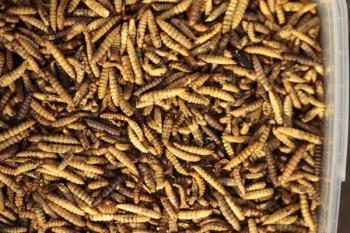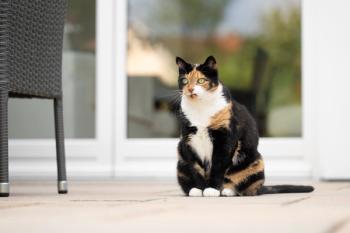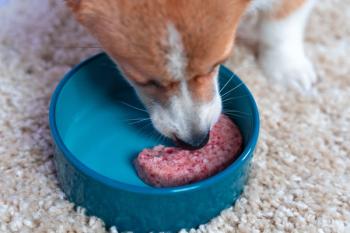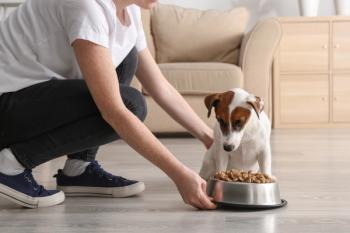
From problem to success: A feline weight loss program that works, growing relationships, not girth in cats (Sponsored by Nestle Purina)
Obesity is the number one nutritional disorder in pets in the western world.
Obesity is the number one nutritional disorder in pets in the western world. Twenty-five percent of cats seen by veterinarians in the United States and Canada are overweight or obese.1 Cats in optimal condition should carry only 15% to 20% body fat.
In 1998, Donoghue and Scarlett studied diet and obesity in cats.2 Using a multivariate statistical analysis controlled for age, they showed that obesity is a risk factor for developing diabetes mellitus, skin problems, hepatic lipidosis, and lameness.
Other researchers3-5 have found that cats (and other species) in a chronic overweight state have an increased risk for
- Hyperlipidemia
- Insulin resistance
- Glucose intolerance
- Lower urinary tract disease
- Anesthetic complications
- Dyspnea associated with Pickwickian syndrome
- Exercise intolerance
- Heat intolerance
- Impaired immune function
- Exacerbation of degenerative joint disorders
- Dermatologic conditions
Many factors can contribute to obesity in cats. Interestingly, mixed-breed cats were found to be at higher risk for becoming overweight than were purebreds.3-5 While this might be genetic, husbandry and owner awareness of the cat may also play roles in determining the cat's weight. By keeping cats indoors, we eliminate their need to defend themselves and to work for their food. We leave them without mental and physical stimulation for much of the day, and we tend to feed them excessive quantities of palatable, calorie-dense diets.
Neutering has also been shown to reduce the energy requirements (resting metabolic rate) of cats by 20% to 25%.6,7 A link has been shown between serum leptin levels and gains in weight and fat following gonadectomy.8 Increased leptin levels may contribute to the decreased insulin sensitivity seen in overweight cats.9
These tendencies make it important that we counsel our clients to measure the amounts of food they feed their cats and to watch carefully for weight gain and adjust caloric intake accordingly. For example, ingesting 10 extra pieces of an average maintenance kibble each day above a cat's basic energy needs can result in a weight gain of 1 lb of body fat in one year. And research shows that the frequency of feeding, as well as the quantity fed, makes a significant difference.10 Given innate feline physiology, feeding cats small meals more often and limiting the number of treats offered is the most appropriate feeding strategy and will assist in weight loss.11,12
Assessing body composition and condition: tools
It is easier to prevent weight gain than to help a cat lose weight. The prevalence of feline obesity increases after 2 years of age, plateaus until about 12 years, and then declines thereafter.13 Cats reach their adult weight at about 12 to 15 months of age. Assuming a cat has an optimal body condition score (BCS) at this time, this weight can be used as a guide to determine an individual cat's ideal size.
To properly assess body composition and condition in your patients, follow these guidelines:
• Record body weight at every veterinary visit.
• Calculate the percent of weight change from the previous visit. This is an invaluable tool for detecting weight change patterns and, in my experience, in helping to identify cats with early chronic illness, including pancreatitis, cholangitis, and bowel malabsorptive conditions (e.g. inflammatory bowel disease, intestinal lymphoma, adenocarcinoma). Likewise, gradual increases can help to identify cats at risk for obesity. Use the above formula to calculate the percent weight change.
• Assess the BCS at every visit, categorizing the individual's shape as emaciated, thin, ideal, heavy, or grossly obese (on a scale of 1 to 9 or 1 to 5). For a cat in ideal condition, the bony prominences of the body (i.e. pelvis, ribs) can be readily palpated but not seen or felt above skin surfaces. There should be insufficient intra-abdominal fat to obscure or interfere with abdominal palpation.
• Assess muscle condition by using a muscle score, which will help define whether weight is adequately proportioned to lean versus fat (Figure 1).
• In questionable cases, use radiography and ultrasonography to assess falciform fat deposits, as well as paralumbar and perirenal fat. In research settings, dual energy x-ray absorptiometry (DEXA) evaluation is used for the most accurate bone density, muscle mass, and fat calculations.
Figure 1. Assessing muscle condition score (MCS)
What to feed
It is not enough to simply feed a cat less of its normal diet. Not only will the patient be unhappy and feel hungry, but all nutrient quantities will be decreased, not just the calories. Instead, the diet should be balanced according to energy content. When cats eat enough of a balanced diet to meet energy requirements, then their protein, vitamin, and mineral needs will also be met.
Exceeding a cat's protein needs beyond maintenance requirements helps induce satiety. When they were fed a diet with 45% of calories from protein, cats lost more fat and less lean mass compared with cats fed a diet with 35% of calories from protein, despite similar total weight loss and rate of weight loss.14
There are a number of approaches to feline weight loss:
1. High protein protects (minimizes loss of) lean mass, stimulates cellular energy metabolism and protein turnover, and may enhance satiety.
2. High moisture can reduce caloric density, which promotes short-term weight loss: It takes a few weeks to a few months for cats to adapt to the lower-caloric density (as fed) in canned foods versus dry foods; however, this only works for some cats.
3. High fiber can reduce caloric density and induce satiety. Some cats will self-restrict calorie intake when fed a dry, high-fiber, low-calorie diet.
4. Low fat will reduce caloric density. High-fat diets are a risk factor for inducing obesity and are generally not considered optimum for a weight loss diet. That said, some cats will lose weight on a high-protein, high-fat, low-carbohydrate diet.
Ultimately, it is the calories ingested versus expended that is required for loss of weight. Given the benefits of achieving lean body mass by feeding a high-protein diet, a goal of at least 40% protein, dry basis, in a low-fat diet (6% to 10% fat) or more protein in a higher-fat diet (12% to 16% fat) is a healthy approach to take.
A cat's daily energy requirement (DER)* is composed of several components:
DER = resting energy requirement (RER)
+ exercise energy requirement (EER)
+ thermic effect of food (TEF)
+ adaptive thermogenesis (AT)
Because the RER varies among individual cats, a manufacturer's recommendations may be too high for a particular cat.
- TEF is the energy spent on digesting and absorbing food.
- AT is the energy used to regulate body temperature.
- DER decreases with increasing age until approximately 12 years of age; thereafter, DER increases in cats.13
* Unlike metabolizable energy requirement (MER), DER includes energy required for activity, such as work, gestation, and growth, as well as energy needed for maintaining normal body temperature.
A clinic weight loss program
For a feline weight-loss program to be successful, three components must be in place: diet, exercise, and recheck/follow-up visits. We need to both reduce the number of calories consumed and increase calorie use and metabolic rate through exercise. Exercising cats could be seen as an oxymoron, but any exercise helps. At its
Weight loss success requires commitment on the part of the client and the veterinary team. Clients rely on us to educate them about feline health and obesity as well as on how to modify their cats' and their own behavior.
Initial assessment
During the initial extended consultation (a 40-minute consultation with the veterinarian), perform a comprehensive physical examination to rule out any concurrent medical problems. Baseline blood work may be advisable, depending on a cat's age and condition. Take a detailed history to become familiar with a cat's current feeding habits and routines. (See "Getting the Diet History" on page 5.)
Have the client start a one- to two-week feeding journal. The client can be asked to begin keeping this journal before the appointment and to bring it with him or her to the visit. Everyone in the household who gives the cat anything to eat should record feedings. The amount and exact types and brands of food and treats should be recorded. A diet journal provides the information needed to determine the caloric intake the cat has been gaining weight on. This intake can then be compared with the cat's recommended caloric allowance. As a rule of thumb, to lose weight a cat should consume only 60% to 70% of the calories required to maintain his or her ideal weight. To summarize:
1. Determine or approximate the cat's ideal weight.
2. Calculate the number of calories needed to maintain the ideal weight (wt in kg X 50 kcal/kg/day).
3. Multiply this number of calories by 60% to 70% for the number of calories to feed each day.
Discuss with clients both the benefits of weight loss and the risks of chronic obesity. Acknowledge their concern and praise them for their desire to take action. Be supportive—they are the ones who will have to do the work. Inform them of their cats' current weight as well as the goal weight. Discuss how long the desired amount of weight loss is likely to take. A safe rate of weight loss is ¼ to ½ lb/month (0.1 to 0.25 kg/month). Knowing this rate will help clients stay on track. Weight losses of 10% to 15% are realistic and attainable and will provide health benefits.
Example: Fluffy weighs 18.6 lb (8.4 kg) with a BCS of 9/9 and is currently being fed 375 kcal day. The goal is 12 lb (5.4 kg) for a BCS of 5-6/9.
12 lb (5.4 kg) X 50 kcal = 271 kcal
Feed 60% to 70% X 271 kcal = 163 to 190 kcal/day
Weight loss of 6.6 lb (3 kg) will take at least 12 months.
An alternative option is to utilize the Veterinary Feeding Guide and Weight management Program software package from Purina Veterinary Diets. The program would start Fluffy on 316 kcal/day of Purina Veterinary Diet OM, calculated to 40 kcal/kg/day, targeting for a weight loss of 2% of initial body weight per week. When Fluffy returns for a recheck after two to four weeks, the practice staff enters information about her actual intake and change in body weight over that time. The program can then determine her individual MER and adjust the feeding recommendation if needed. Since the MER is based on average, the initial rate of loss may be more or less than anticipated. The benefit of this approach is that the recommendation is customized to fit the needs and metabolism of the individual patient.
Educate clients as to why cats become overweight. Pet food manufacturers make foods sufficiently palatable so that cats will eat them enthusiastically and consumers will purchase those foods again. Because fat is palatable for cats and is a relatively inexpensive ingredient, many cat foods are energy-dense, with most of the calories coming from fat. In addition, because it is convenient to feed ad libitum, cats will snack all day on high-calorie kibble and can easily eat more than the eight to 10 small (30-kcal, or mouse-sized) meals a day they would in their native state. And pet cats generally lack exercise when compared with the hunter they were designed to be.
The TEF is the energy cost of digesting and absorbing food. As mentioned earlier, TEF is higher when meals are small and frequent, so feeding multiple small meals is preferable to feeding one or two large meals. One way to incorporate this into the diet—and give the cat a little challenge (and exercise)—is to divide the day's food into six or seven small portions, placing it on saucers throughout the home as if the cat were on a treasure hunt. Such feeding makes the cat less likely to gorge and entices him or her to look for more, all of which has a higher TEF cost.
But there is more to obesity control than energy intake and energy expenditure. A more holistic approach can provide a greater chance of success. We must also consider why a cat is overeating. Is the cat bored? Is the cat not receiving enjoyable stimuli from other, healthier sources? What other normal behaviors are unavailable for the cat to participate in? How is the cat meeting his or her "hedonic budget"? Chronic stress, often present in the confined indoor cat, results in neuroendocrine changes that predispose to obesity.15
What drives the client?
In addition, find out what drives the client. In an interesting study, researchers found that the "positive strokes" clients receive from their cats and clients' behaviors toward their cats differed with a cat's weight.16 To quote from the paper itself:
"Thirty percent of owners of overweight cats compared with 12% of owners of normal [weight] cats stated that they did not feel very happy prior to acquiring a cat, and the cat was intended to console and encourage them. These results are suggestive of 1) a closer relationship between overweight cats and their owners than between normal cats and their owners, 2) more over-humanization of overweight cats than of normal cats, 3) a potential role of overweight cats as a substitute for human companions."16
The same study found that people with overweight and obese cats tend to underestimate their cats' BCS and to talk to their cats more about their work, family, and friends than do people living with normal-weight cats.16 Not surprisingly, people with overweight cats were more likely to get positive feelings from watching their cats eat, whereas people with cats of normal weight spent more time playing with their cats. In this study, while there was "no significant difference between the number of meals and snacks and the type of food received by normal and overweight cats, the overweight cats more often received fresh meat and kitchen scraps or various extra treats added to their regular food," and cats of normal weight were more likely to get moist food than were obese cats.
Somewhat curiously, the people with overweight cats were more interested in their own health than were clients with cats of normal weight. Conversely, the owners of the obese cats considered preventive care for their cats to be less important than did the group of clients with healthy cats.15
So, in a cat's weight there is an element of meeting the hedonic budget of the people who live with the cat as well. Hence, when it comes to feline weight control, it is essential to address the behavior of the people who live with and feed the cat. Encouraging alternative "strokes"—things that make clients feel good about their interactions with their cats, such as play and feeling proud of achieving weight loss goals—are not to be taken lightly. Positive feedback from the veterinary team (the outside environment) as well as feedback self-generated by the client is essential to the success of a feline weight loss program.
Giving clients the right tools
All key family members must play a role in making the behavior modifications necessary for a successful feline weight loss program. Look for forms of interaction the client can have with the cat other than feeding. Treats are the downfall of many weight control programs. It is best if one person handles all the feedings, while others bond through other means (catnip, combing, playing). Feeding a cat multiple small meals as a treasure hunt is beneficial. Ask clients whether their cats prefer toys that mimic bird movement (flying) or mouse movement (scrambling). Have clients develop new routines of playing with their cats several times a day to add interest and exercise to their cats' lives. The expense of these changes might be only the cost of a bag of catnip and a new toy.
Create a bar graph to track a cat's weight and maintain this graph on the clinic computer and in the cat's medical record (Figure 2). Send a copy of the updated graph home with the client at every visit as a reminder of the cat's success level.
Figure 2. Biweekly Weight
Finally, follow-up is vital to a successful feline weight loss program. (See "Follow-up Is Key" on page 5.) A technician or nurse (program supervisor) should become the client's buddy and be in charge of all follow-up. No weight loss program is effective without follow-up.
Margie Scherk, DVM, DABVP (feline)
Vancouver, B.C., Canada
References
1. Scarlett JM, Donoghue S, Saidla J, et al. Overweight cats: prevalence and risk factors. Int J Obes Relat Metab Disord 1994;18 suppl 1:S22-S28.
2. Donoghue S, Scarlett JM. Diet and feline obesity. J Nutr 1998;128(12 suppl):2776S-2778S.
3. German AJ. The growing problem of obesity in dogs and cats. J Nutr 2006;136(7 suppl):1940S-1946S.
4. Appleton DJ, Rand JS, Sunvold GD. Feline obesity: Pathogenesis and implications for the risk of diabetes. Proc 2000 Iams Nutr Symp 2000:81-90.
5. Burkholder WJ, Toll PW. In: Hand, MS, Thatcher, CD, Remillard, RL, et al (ed): Small Animal Clinical Nutrition (4th ed). Topeka, Kan: Mark Morris Institute. 2000;401-430.
6. Biourge, V. Feline nutrition update. Proc World Small Anim Vet Assoc Congr 2001.
7. Harper EJ, Stack DM, Watson TD, et al. Effects of feeding regimens on bodyweight, composition and condition score in cats following ovariohysterectomy. J Small Anim Pract 2001;42(9):433-438.
8. Martin L, Siliart B, Dumon H, et al. Leptin, body fat content and energy expenditure in intact and gonadectomized adult cats: a preliminary study. J Anim Physiol Anim Nutr (Berl) 2001;85(7-8):195-199.
9. Appleton DJ, Rand JS, Sunvold GD. Plasma leptin concentrations are independently associated with insulin sensitivity in lean and overweight cats. J Feline Med Surg 2002;4(2):83-93.
10. Russell K, Sabin R, Holt S, et al. Influence of feeding regimen on body condition in the cat J Small Anim Pract 2000;41(1):12-17.
11. Michel, KE. Feline nutrition: fundamentals and clinical relevance. Proc ABVP Symp 2002.
12. Michel, KE. Weight reduction in cats: great frustrations in feline nutrition. Proc World Small Anim Vet Assoc Congr 2001.
13. Cupp CJ, Jean-Philippe C, Wendell W. Kerr WW, et al. Effect of nutritional interventionson longevity of senior cats. Intern J Appl Res Vet Med 2006;4(1):34-50.
14. Laflamme DP, Hannah SS. Increased dietary protein promotes fat loss and reduces loss of lean body mass during a weight loss in cats. Intl J Appl Res Vet Med 2005;3(2):62-68.
15. Buffington CAT. External and internal influences on disease risk in cats. J Am Vet Med Assoc 2002;220(7):994-1002.
16. Kienzle E, Bergler R. Human-animal relationship of owners of normal and overweight cats. J Nutr 2006;136(7 suppl):1947S-1950S.
Getting the Diet History
During the initial weight loss consultation, it is important to ask the following questions:
- What specific amounts and type of food (all, including treats) are fed to the cat? Does the cat drink milk? Is he or she fed "people" food?
- Who feeds the cat's regular meals? Do family members routinely feed treats and table scraps?
- How often is the cat fed? Is the food measured?
- Does the cat nibble or gorge?
- Where is the cat fed?
- Does the cat receive any medications? If so, are the medications given in food or with a treat?
- Is the cat indoor or outdoor? If outdoor, does he or she routinely hunt?
- What other pets are in the household?
- Do other pets have access to the overweight cat's food?
- Does the overweight cat have access to the other pets' food?
- What is the activity level of the cat?
- Are there any known stress factors in the home environment?
Follow-up Is Key
- Assign a technician or nurse to be the client's "buddy" in charge of follow-up.
- Review program features.
—Unlimited buddy phone support
—Program lasts six months and is renewable if necessary
- Week 1—Support phone call
- Week 2 and subsequent biweekly appointments:
—Schedule a 15-minute visit with the program supervisor and the veterinarian.
—Weigh patient biweekly using the same scale.
—Talk with owners about highlights or problems.
—Update the bar graph and send it home with the client at each biweekly meeting.
- After four months, a plateau may occur, and new calculations may be needed to promote further safe weight loss.
Newsletter
From exam room tips to practice management insights, get trusted veterinary news delivered straight to your inbox—subscribe to dvm360.






